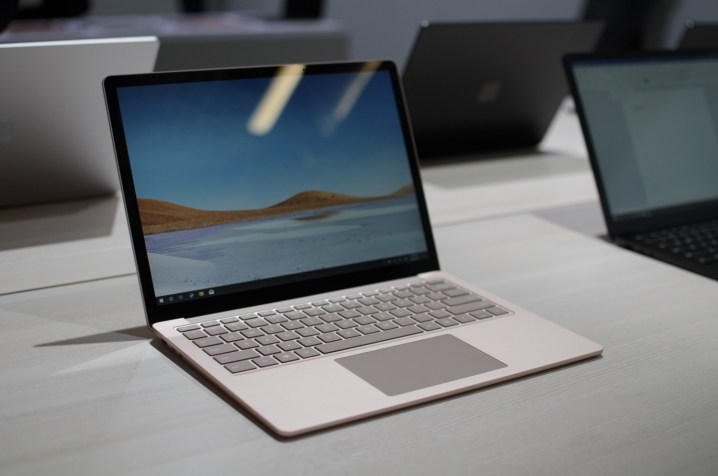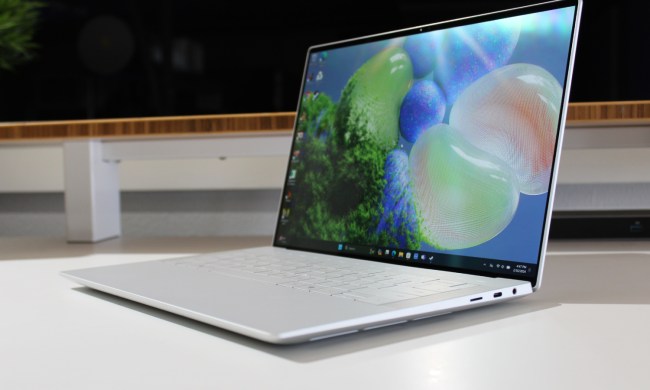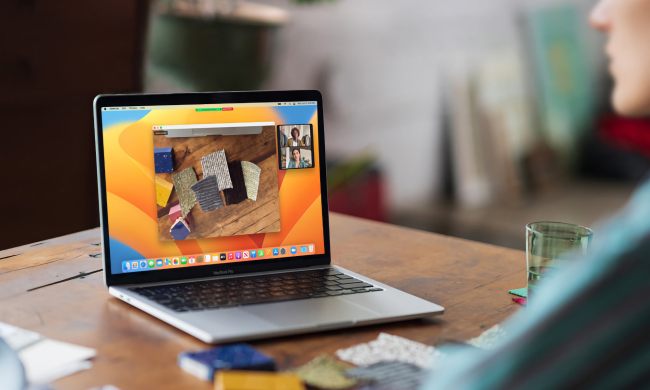When it comes to buying a laptop, two of the biggest brands to consider are Apple and Microsoft. Apple has long been famous for its MacBook Pro lineup, but Microsoft also planted a flag in the laptop world with the introduction of the Surface Laptop in 2017.
Microsoft is now back with the new Surface Laptop 3, and in a larger 15-inch design. It’s easy to draw comparisons with the 15-inch MacBook Pro, both in terms of design and function. But now that the 15-inch model is no longer a product, a more apt comparison is the newer 16-inch model, launched at the end of 2019.
In this side-by-side specs comparison, we’ll give the design, performance, and portability of the two devices a look, helping you decide which one is right for you.
Design

Both the MacBook Pro and the Surface Laptop 3 feature a sturdy aluminum finish. That is new for the Surface Laptop line as it is now moving away from the more divisive, Alcantara keyboard fabric that has plagued it in the past.
In terms of dimensions, the MacBook Pro 16-inch measures 14.09 by 9.68 by 0.64 inches. The Surface Laptop 3, meanwhile, comes in at 13.4 by 9.6 by 0.57 inches. That makes Surface Laptop slightly smaller and thinner than the MacBook Pro. It’s also lighter at 3.4 pounds, over the 4.3 pounds of the MacBook Pro.
Naturally, both devices stay true to the traditional clamshell design. However, the Surface Laptop 3 has the added benefit of a 10-point multi-touch screen and support for the Surface Pen. It comes in at 15 inches and with 2,496 x 1,664 resolution (201 pixels per inch).
The MacBook Pro, meanwhile, sports a 16-inch screen with 3,072 x 1,920 resolution, or 226 PPI. The MacBook Pro packs more pixels and is known for its highly-accurate screens, tailor-made with photographers and content creators in mind.
There’s also a difference in their aspect ratio, too. The MacBook Pro uses a 16:10 panel, while the Surface Laptop 3 has an even taller 3:2 shape. The extra vertical space of the Surface Laptop 3 makes it a great productivity machine, especially browsing tall websites.
Other design areas worth considering are the keyboards and touchpads. The latest MacBook Pro ditches Apple’s controversial butterfly mechanism keyboard for what it calls the Magic Keyboard, which is the best we’ve seen on a MacBook to date — finally. It provides a one-millimeter key travel distance versus the 1.3mm distance offered on the Surface Laptop 3.
As for the touchpad, the MacBook Pro’s version is the best you can get on a laptop. Period.
Finally, the MacBook Pro includes Apple’s signature Touch ID sensor and integrated Touch Bar, while the Surface Laptop 3 boasts its Windows Hello IR camera for facial recognition.
Performance

On the 16-inch MacBook Pro, you have two starting points. With the $2,399 model, you have options for the six-core Intel Core i7-9750H or the 8-core Intel Core i9-9980HK processor. With the $2,799 model, your processor options are the Core i9-9880H eight-core chip or the Core i9-9980HK eight-core chip. These are incredibly powerful processors stuffed into the thin chassis of the MacBook Pro, making for an impressive content creation device.
Apple also provides options for discrete graphics: AMD’s Radeon Pro 5300M, Radeon Pro 5500M 4GB, Radeon Pro 5500M 8GB.
Microsoft’s Surface Laptop 3 takes a different route. For the first time ever in a Surface device, Microsoft offers AMD Ryzen APUs customized specifically for the Surface Laptop 3. This includes both the AMD Ryzen 5 3580U with Vega 9 graphics or the Ryzen 7 3780U with Vega 11 graphics. AMD’s Vega 9 has nine graphics cores, and the Ryzen 7 a total of 11 graphics cores.
While we give a thumbs up for Microsoft’s partnership with AMD, these Ryzen APUs are a generation behind their desktop brethren. As we stated in our review of the Surface Laptop 3, they don’t see the benefits of AMD’s Zen 2 design. That said, the Ryzen 5 chip installed in Microsoft’s 15-inch laptop is on par with Intel’s eighth-generation Core U-Series chips. It just can’t compete with the ninth-generation competition found in the current 16-inch MacBook Pro.
Still, Microsoft said it worked with AMD to assure performance was optimum. Surface chief Panos Panay also hinted that these devices could run Fortnite. After performing an in-house analysis, we believe the custom APUs are tweaks of the Ryzen 5 3500U and the Ryzen 7 3700U. Running Fortnite on Vega 9 was indeed “a serious stretch.”
In the end, the Surface Laptop 3 doesn’t compete with the high core count of the MacBook Pro.
Portability

You can expect the MacBook Pro 16-inch model to last you around 11 hours, but we experienced around five and a half hours with dozens of tabs open, streaming music in Spotify, and using Slack.
As for the Surface Laptop 3, Microsoft claims around 11.5 hours with typical productivity usage. That would be around the same as we previously experienced with Intel-based devices like the Dell XPS 15. The Surface Laptop 3 manages to live up to Microsoft’s claims thanks to optimizations in Windows 10 and the customized AMD APUs.
For ports, both devices are well connected, but one has an advantage over the other. The MacBook Pro features four Thunderbolt 3 (USB-C) ports and a headphone jack. Thunderbolt 3 is a plus, as it means you can connect an external GPU to the device and daisy-chain displays.
That gives it a slight edge over the Surface Laptop 3, which sports an older USB-A port, one USB-C port, the Surface Connect Port, and headphone jack. Microsoft’s setup makes charging easy, as you can charge either via the magnetic Surface Connect or with USB-C when on the go. It also means that you won’t need to embrace dongles, as one older USB-A port can be used to connect USB drives, printers, and more.
Unless you need serious power, get a Surface Laptop 3

Ultimately, price is likely the big selling point. Apple’s MacBook Pro starts at $2,399 whereas Microsoft’s Surface Laptop 3 starts at a much lower $1,199.
But here’s the thing: Those starting prices reflect their overall performance. If you want a powerful laptop with loads of storage, the MacBook Pro is your ideal solution. If you want something more mainstream and don’t want to pay the MacBook Pro prices, Microsoft’s Surface Laptop 3 is your ticket to mobile computing.
Look at this another way. The $2,799 MacBook Pro — and this is the starting configuration — packs the Core i9-9880H eight-core CPU, discrete Radeon Pro 5500M graphics, 16GB of system memory, 1TB of storage, and a 16-inch screen with a 3,072 x 1,920 resolution. Throw in Thunderbolt 3 connectivity and Apple’s Touch Bar, and you have a meaty little laptop.
Meanwhile, the $2,799 Surface Laptop 3 features AMD’s Ryzen 7 3780U four-core all-in-one chip with no discrete graphics, 32GB of system memory, 1TB of storage, and a 15-inch touch-capable screen with a 2,496 x 1,664 resolution. Its USB-A connectivity means you don’t need to purchase a separate dongle to use a traditional mouse or keyboard.
The differences in CPU and GPU alone make the MacBook Pro a better buy on the hardware front. The only potential sticking point is that it’s based on MacOS, which isn’t bad whatsoever, but if you’re not accustomed to Apple’s operating system, you’ll have a huge learning curve. To save long-time Windows users frustration, the Surface Laptop 3 may be more ideal — unless they’re willing to learn a new platform.
Overall, Microsoft provides a wider pricing tier, from addressing customers on a budget to those with bigger wallets. The only way you can get into the lower range with Apple is to fall back to its 13-inch model.



